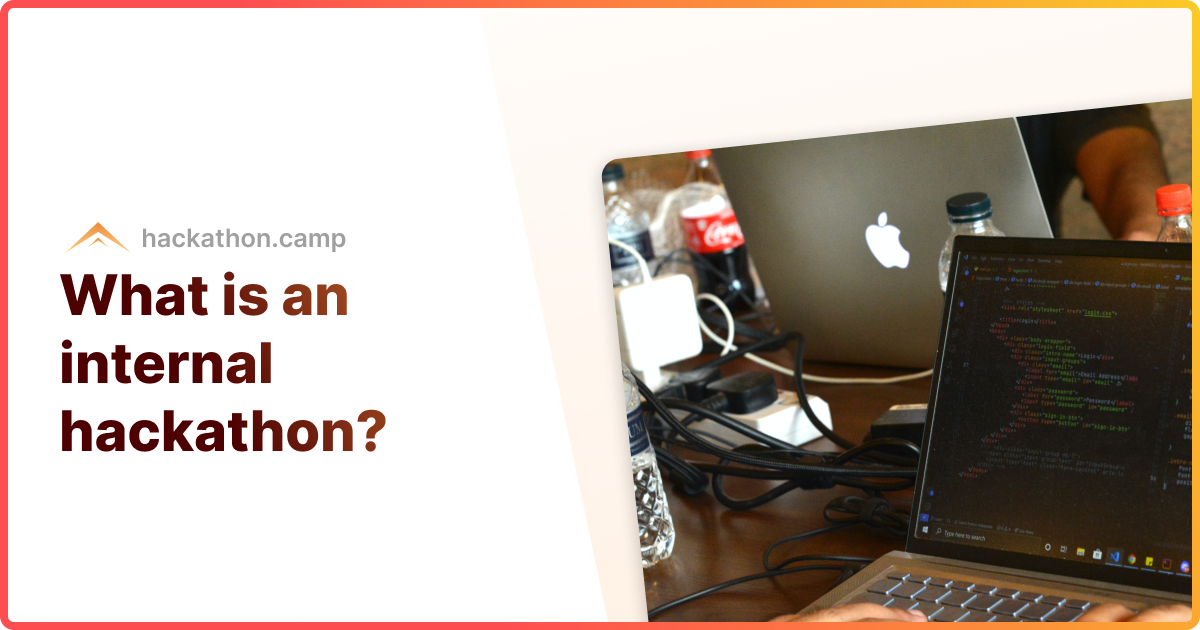July 27, 2022
What is an internal hackathon?
Kevin Peters
Founder of tooltipr

An internal hackathon is an event that you hold in your organization internally. The event builds around the idea of creating projects together with smaller groups in a limited time frame. There will be winning projects with prizes and many cool other activities during the hackathon.
Internal hackathons usually aim to bring employees closer together. They can help form a bond between employees. Ideally, they can contribute to a better company climate and could also empower people to stay longer within your company.
Ideas for themes of an internal hackathon
Finding a theme for an internal hackathon can be pretty challenging. First of all, you have to decide what kind of hackathon you want to create. There are two kinds:
Business-oriented
Fun-oriented
Both forms of hackathons have their advantages and disadvantages. Business-oriented hackathons normally involve the product or project your team is working on. The biggest advantage is that your colleagues spend time with your product and build solutions around or on top of it. This kind of hackathon brought many cool new ideas to companies like Spotify. Spotify, for example, organized many “hack weeks” which are a type of hackathon as well. In these “hack weeks” the company mostly focuses on building internal solutions to make the life of employees at Spotify easier or to improve the customer experience. You can see this in the article “Dogfooding developer products: gathering insights from internal hackathons”. Most themes focus around internal tooling, the usage of one internal product, or streamlining internal workflows or processes.
Fun-oriented hackathons, on the other hand, mostly cover generic topics with their main purpose being bringing the company together. These are not so much about moving forward business-wise, but increasing employee happiness.
Most fun topics are about something that excites employees, ranging from something technical like Crypto to movies. Social applications that connect people are often built in these kinds of hackathons. Projects within fun-oriented hackathons can still include projects that benefit the company though. For example, people could create an app or web app to connect people for lunches or other activities.
How to organize an internal hackathon
Organizing a hackathon is tedious and time-consuming. A hackathon organizer's tasks usually include:
Finding a topic for the hackathon
Preparing marketing material to attract participants for the hackathon
Creating a form to collect ideas
Sending out a form to every employee to collect their ideas
Sending out a form to every employee to gather their team or project preferences
Organizing and assigning teams
Getting feedback and reshuffling teams
Scheduling the whole hackathon from an opening presentation, when teams work on their projects, pizza breaks, and other activities during the hackathon up until the hackathon end
Assigning meeting rooms or creating virtual meetings using zoom, hangouts, or other platforms for the teams
Providing all the tools needed to work on projects like GitHub repositories, Figma projects, and similar
Creating an opening presentation and holding the opening presentation
Organizing food during the event
Collecting all ideas at the end in form of a presentation or similar
Organizing a presentation where each team can showcase their project
Organizing voting can happen in different ways. For example with a jury or open voting by the whole company
Figuring and handing over the prize for winning projects
As you can see the process of organizing an internal hackathon is quite extensive. Us from hackathon.camp recommend taking at least one month to prepare for the hackathon alone. You can speed up the whole process by using our tool though, as we provide templates for most of the communication you will be sending out and automate everything about the process from team assignments to voting.
Another tip is to find multiple hackathon organizers. By splitting the workload of the organization you will keep yourself sane and can get a smoother experience during the hackathon. Make sure that everyone knows what their tasks are, though.
Team organization and keeping the teams up to date with the schedule is something you should spend some time on. These tasks are often the most time-consuming activities, especially when done wrong. Try to assign teams before the hackathon starts. This will ensure that teams can talk together before the hackathon and can expect to work in a group together right away rather than spending trying to find the “perfect” group.
Keeping up with the schedule of the hackathon is also really difficult. Most people do not check a schedule actively, so it is part of the organizers' responsibility to keep the participants up to date. You can do this by publishing a schedule way ahead of the hackathon, ideally in some kind of calendar view. When changes to the schedule happen, like when food deliveries take longer than expected, resulting in subsequent hackathon events being delayed, send a message to every participant that the schedule has changed. Ideally, give the participants some extra time to work on their projects.
Things not to do during the hackathon
As a hackathon organizer, do not participate in the hackathon. You are there to organize, answer all the questions about the event, schedule the milestones, and collect all the data regarding the hackathon. Be there for your employees help them however you can. If someone does not want to work on a specific project you have assigned them to, help them find another solution. There is always a solution!
As we mentioned earlier, do not wait until the main day of the event to organize teams. It will make the process much easier if you plan and assign teams in advance. Another thing we have seen that work well at hackathon.camp is to set some rules, but not to be too restrictive. This is important to keep participants moving within a set of boundaries while allowing them to use their creativity to find good and interesting projects.
hackathon.camp
© 2025 hackathon.camp. All rights reserved